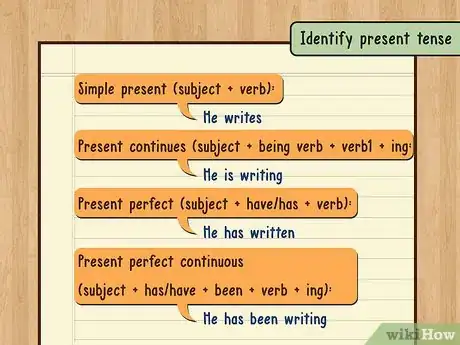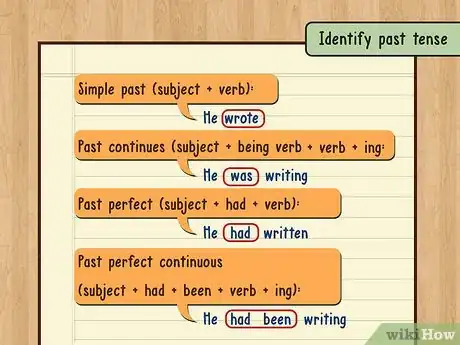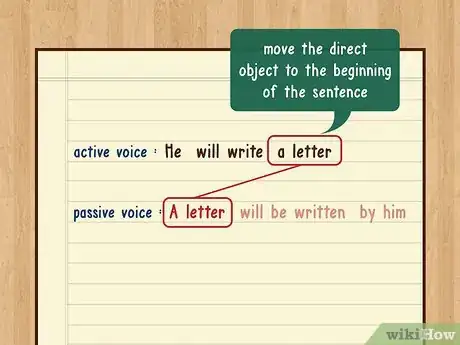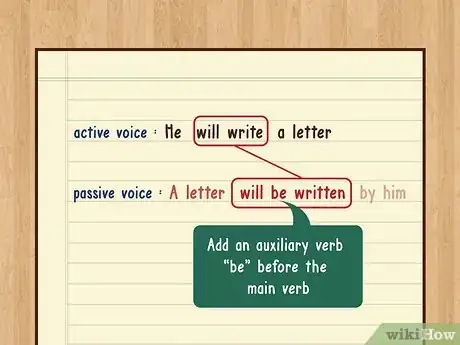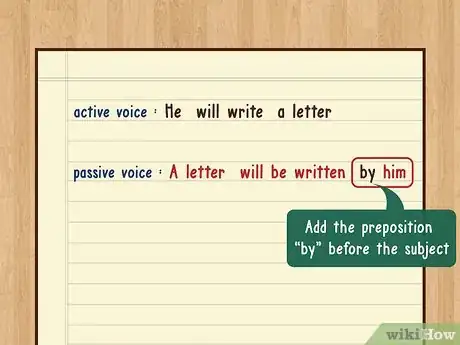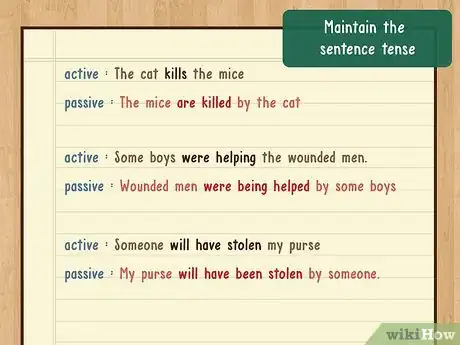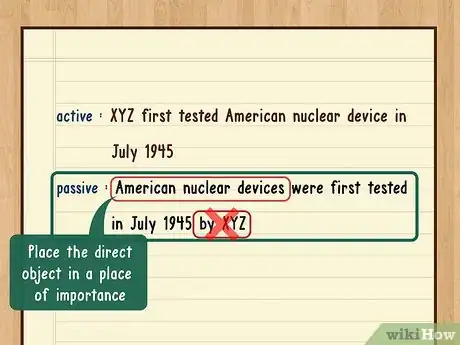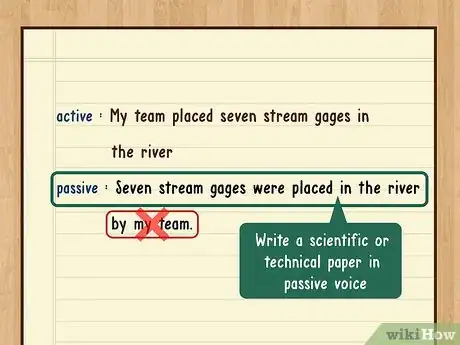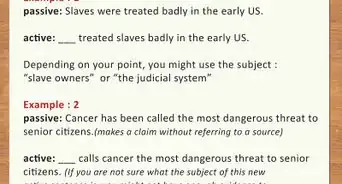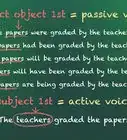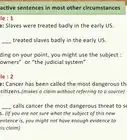This article was co-authored by Richard Perkins. Richard Perkins is a Writing Coach, Academic English Coordinator, and the Founder of PLC Learning Center. With over 24 years of education experience, he gives teachers tools to teach writing to students and works with elementary to university level students to become proficient, confident writers. Richard is a fellow at the National Writing Project. As a teacher leader and consultant at California State University Long Beach's Global Education Project, Mr. Perkins creates and presents teacher workshops that integrate the U.N.'s 17 Sustainable Development Goals in the K-12 curriculum. He holds a BA in Communications and TV from The University of Southern California and an MEd from California State University Dominguez Hills.
There are 10 references cited in this article, which can be found at the bottom of the page.
This article has been viewed 406,084 times.
Switching voice is an important skill to possess when writing in any context, including academically, professionally, or personally. Changing a sentence from active to passive voice does not change the meaning of the statement, but it does switch the emphasis from the subject (the person doing the action) to the direct object (the thing that receives the action). To change a sentence to passive voice, you’ll first need to identify the tense that the sentence is written in, as it’s necessary to keep the correct tense when switching from active to passive voice. Second, identify the sentence’s subject, verb, and direct object. Finally, change the format so that the sentence begins with the direct object and ends with the subject.
Steps
Identifying the Tense of the Sentence
-
1Identify different types of present tenses. The present tense describes action being done in the present moment—not future, not past, and not a hypothetical action. The English language has a simple present tense, a present continuous tense, a present perfect tense, and present perfect continuous tense.[1] All indicate action in the present, but differ in their descriptions of how long the action has been taking place.
- Simple present tense combines a subject + verb. For example: “He writes.”
- Present continues tense combines a subject + being verb (am, is , are) + verb1 + ing. For Example: “He is writing.”
- Present perfect tense combines a subject + have/has + verb. For example: “He has written.”
- Present perfect continuous tense combines subject + has/have + been + verb + ing. Example: “He has been writing.”
-
2Identify different past tenses. Just as English has multiple present tenses, the language also possesses multiple past tenses. English has a simple past tense, as well as past perfect, past continuous, and past perfect continuous tenses.[2] All past-tense sentences describe something that has already occurred.
- Simple past tense combines a subject + verb in the sentence. For example: “He wrote.”
- Past perfect tense combines the subject + had + verb. For example: “He had written.”
- Past continuous tense combines a subject + being verb (was, were) + verb + ing. For example: “He was writing.”
- Past perfect continuous tense combines subject + had + been + verb + ing. For example: “He had been writing.”
Advertisement -
3Identify future tenses. Like present and past tenses, English has multiple forms of the future tense. Each version indicates an action that has not yet occurred—but will occur in the future—and the distinctions between different types of future tense signify the completion or incompletion of the future act.[3]
- Simple future tense combines a subject + “will” + verb. For example, “He will write.”
- Future perfect tense combines the subject + “will have” + verb. For example, “He will have written.”
- Future continuous tense combines a subject + “will” + being verb + verb. For example, “He will be writing.”
- Future perfect continuous tense combines the subject + “have been” + verb + “ing.” For example, “He will have been writing.”
Converting the Sentence
-
1Move the object to the beginning of the sentence. Sentences in the active voice typically begin with the subject and describe the action it does to the direct object. To achieve the passive voice, switch this placement by moving the direct object to the beginning of the sentence.[4] This will highlight the object and its reception of the verb.
- For example, the sentence “He will write a letter” is in the future tense and active voice.
- To change this to passive voice, move the direct object to the beginning of the sentence, while keeping the future tense: “A letter will be written by him.”
-
2Add an auxiliary verb “be” before the main verb. Adding a “be” verb will make the active verb passive, and highlight the way the direct object was acted upon, rather than how the subject performed that action (as in an active-voice sentence).[5] [6]
- Depending on the tense of the sentence, being verbs include: “is,” “was,” “will be,” “has been,” etc.
-
3Add the preposition “by” before the subject. The subject (preceded by “by”) should come at the end of the passive-voice sentence.[7] By stating “by” late in the sentence, you’ll add the subject after the direct object and verb have already been clarified.[8] For example: “The stretch of highway was paved by the construction crew.”[9]
- In cases where the subject (one who does the action) is unknown, you may not be able to add the word “by.”
- For example, if you have received a letter but do not know who sent it, you would write, “The letter was sent to me on November 1st,” but you would not say by whom it was sent.
-
4Maintain the sentence tense. While switching from active to passive voice, be sure to maintain the correct tense from the original sentence. Keep any auxiliary verbs: verbs which modify the tense of the main verb. Auxiliary verbs include “be,” “can,” “do” and “have.” Read the passive-voice sentence over to yourself to make sure it has the same tense as the former active-voice sentence. For example:[10]
- Active voice, present tense: The cat kills the mice.
- Passive voice, present tense: The mice are killed by the cat.
- Active voice, past continuous tense: Some boys were helping the wounded men.
- Passive voice, past continuous tense: Wounded men were being helped by some boys.
- Active voice, future perfect tense: Someone will have stolen my purse.
- Active voice, future perfect tense: My purse will have been stolen by someone.
Knowing When to Use the Passive Voice
-
1Remove emphasis from the subject. While the passive voice is discouraged in some instances because it can be a sign of weak writing, there are plenty of situations where it’s appropriate.[11] The active voice firmly places the subject—the one who does the action—at the beginning of the clause, passive voice can obscure the subject, focusing instead on the direct object receiving the action.[12]
- Be careful when removing emphasis from the subject of a sentence, as in some cases it can be seen as confusing to the reader. Passive voice can also remove the subject of a sentence altogether.
- For example, a politician who says, “I have lied to the American people” may be seen as repentant and forthcoming. If the individual were to say “The American people have been lied to,” they politician would be removing any blame from themselves by phrasing the sentence in the passive voice and removing the subject.
-
2Place the direct object in a place of importance. If the subject of your sentence is relatively unimportant, while the direct object and the action done to it are significant, the passive voice can be used. Writers often use the passive voice when describing an event or occurrence in which the direct object or action is more relevant than the subject of the sentence.[13]
- For example, the sentence “American nuclear devices were first tested in July 1945” places the emphasis on the nuclear testing and leaves the specific researchers anonymous.
-
3Writing a scientific or technical paper in passive voice. In science writing, the passive voice is used to indicate objectivity and detachment from the topic or investigation of the paper. Within a scientific paper, sections describing “Methods,” “Materials,” or “Processes” are nearly always written in passive voice.[14]
- For example, instead of writing “My team placed seven stream gages in the river,” you would write, “Seven stream gages were placed in the river.”
- Here the passive voice lends anonymity to the action: anyone can replicate the experiment by repeating the same procedures. By using the passive voice, you’re arguing that the results can be replicated regardless of which scientists perform the actions.
Expert Q&A
-
QuestionHow do you write in passive voice?
 Richard PerkinsRichard Perkins is a Writing Coach, Academic English Coordinator, and the Founder of PLC Learning Center. With over 24 years of education experience, he gives teachers tools to teach writing to students and works with elementary to university level students to become proficient, confident writers. Richard is a fellow at the National Writing Project. As a teacher leader and consultant at California State University Long Beach's Global Education Project, Mr. Perkins creates and presents teacher workshops that integrate the U.N.'s 17 Sustainable Development Goals in the K-12 curriculum. He holds a BA in Communications and TV from The University of Southern California and an MEd from California State University Dominguez Hills.
Richard PerkinsRichard Perkins is a Writing Coach, Academic English Coordinator, and the Founder of PLC Learning Center. With over 24 years of education experience, he gives teachers tools to teach writing to students and works with elementary to university level students to become proficient, confident writers. Richard is a fellow at the National Writing Project. As a teacher leader and consultant at California State University Long Beach's Global Education Project, Mr. Perkins creates and presents teacher workshops that integrate the U.N.'s 17 Sustainable Development Goals in the K-12 curriculum. He holds a BA in Communications and TV from The University of Southern California and an MEd from California State University Dominguez Hills.
Writing Coach & Academic English Coordinator Well, word choices are everything! Try to describe actions with more powerful synonyms whenever possible. For example, "The boy heard a loud sound and became scared" is an okay sentence, but "The explosion rocketed the room and the boy hid under his bed" sounds better. Why? Because the word explosion makes it loud and tells me it is dangerous.
Well, word choices are everything! Try to describe actions with more powerful synonyms whenever possible. For example, "The boy heard a loud sound and became scared" is an okay sentence, but "The explosion rocketed the room and the boy hid under his bed" sounds better. Why? Because the word explosion makes it loud and tells me it is dangerous. -
QuestionWhat is the passive voice of; "Mark changes the flat tire?"
 Community Answer"The flat tire is changed by Mark" would be the passive version of that sentence.
Community Answer"The flat tire is changed by Mark" would be the passive version of that sentence. -
QuestionHow do I change, "The teacher will correct the papers"?
 Community Answer"The papers will be corrected by the teacher" is the passive voice of this sentence.
Community Answer"The papers will be corrected by the teacher" is the passive voice of this sentence.
References
- ↑ https://learnenglish.britishcouncil.org/grammar/english-grammar-reference/present-tense
- ↑ https://learnenglish.britishcouncil.org/grammar/english-grammar-reference/past-tense
- ↑ https://www.thesaurus.com/e/grammar/future-tense-verbs/
- ↑ https://owl.purdue.edu/owl/general_writing/academic_writing/active_and_passive_voice/active_versus_passive_voice.html
- ↑ Richard Perkins. Writing Coach & Academic English Coordinator. Expert Interview. 1 September 2021.
- ↑ https://webapps.towson.edu/ows/activepass.htm
- ↑ https://webapps.towson.edu/ows/activepass.htm
- ↑ http://www.lingolex.com/tensexp.htm
- ↑ http://examples.yourdictionary.com/examples-of-active-and-passive-voice.html
- ↑ https://www.hunter.cuny.edu/rwc/repository/files/grammar-and-mechanics/verb-system/Active-and-Passive-Voice.pdf
- ↑ Richard Perkins. Writing Coach & Academic English Coordinator. Expert Interview. 1 September 2021.
- ↑ http://www.writing.utoronto.ca/advice/style-and-editing/passive-voice
- ↑ http://www.writing.utoronto.ca/advice/style-and-editing/passive-voice
- ↑ http://www.writing.utoronto.ca/advice/style-and-editing/passive-voice
About This Article
To change a sentence from active to passive voice, start by moving the object to the beginning of the sentence. Then, add the auxiliary verb “be” prior to the main verb, which will emphasize how the object is acted on. For example, if the original sentence is “He will write the letter,” you should make it “A letter will be written by him.” Take care to keep the same tense when you switch a sentence from active to passive voice. If the original sentence is “The cat kills the mice,” the correct passive voice would be “The mice are killed by the cat,” not “The mice were being killed by the cat.” For tips on when it’s OK to use the passive voice and when to avoid it, keep reading!
